
In 2024, A Detailed Guide on Faking Your Location in Mozilla Firefox On Motorola Edge 40 | Dr.fone

A Detailed Guide on Faking Your Location in Mozilla Firefox On Motorola Edge 40
Mozilla Firefox is one of the most famous browsers known for its security. Like other browsers, it also tracks your location and shares it with websites. Although Firefox asks for your permission before sharing your location, it can still be a privacy concern for many people. For many reasons, disabling your location is disadvantageous, so Firefox spoof location can resolve your concerns.
It is not hard to change or spoof your location in Mozilla Firefox. Stick with this article to learn different ways to fake a location in Firefox on devices.

Disclaimer: This post includes affiliate links
If you click on a link and make a purchase, I may receive a commission at no extra cost to you.
Part 1: Preparations Before Spoofing Your Location in Firefox
Before starting with Firefox location spoof, you must be aware of how the platform and websites determine your location. There are many ways a browser can detect your location. It includes services like IP addresses, GPS tracking, Wi-Fi, and Bluetooth. The main tool browsers and websites use to determine your location is HTML5 Geolocation API.
1. Basic Understanding of the HTML5 Geolocation API
Basically, a browser API called HTML5 Geolocation API is used by websites and browsers to detect a user’s location using longitude and latitude coordinates. It is strictly based on user permissions for detecting location. That means you will receive a permission prompt whenever a website or browser uses it to detect your location. If you refuse the permission, they can’t use this API for location determination.
2. How Does HTML5 Geolocation Work?
HTML5 Geolocation determines your location using the longitude and latitude coordinates with the help of GPS. If your device doesn’t have GPS tracking, it uses Wi-Fi and cell tower signals to detect the Motorola Edge 40 device’s location. The location detected by HTML5 Geolocation is highly accurate with accuracy up to street level. Due to its high precision in locating users, it can create privacy issues for users.
Part 2: How to Fake Your Location in Mozilla Firefox on Computers
Many ways are available for you to fake or disable your desktop location in Mozilla Firefox to address your privacy concerns. You can either disable or change the location in the browser or use a third-party app or extension. Below, we have explained the three most common ways to fake or disable your location in Firefox.
Method 1: Disable Geolocation in Firefox
If you want to stop websites from accessing your location from Mozilla Firefox, you can disable the geolocation feature using Firefox Settings. The process to disable your location in Mozilla Firefox is covered using these steps:
Step 1: Open Mozilla Firefox on your computer to disable its location. Click the “Three Vertical Bars” icon to select “Settings.” Now, tap “Privacy & Security” from the left sidebar and navigate to “Permissions.”

Step 2: Click “Settings” in front of “Location” to manage the location settings. It will open a window with a list of all the websites that can access your location. Depending on your needs, you can choose between “Remove Web Site” or “Remove All Web Sites” to remove their location access.

Step 3: If you want to block the websites from accessing your location indefinitely, you can select the “Block new requests asking to access your location” option. Once selected, click “Save Changes” to disable your geolocation on Firefox.

Method 2: Manually Change Your Firefox Location
Disabling your location on Mozilla Firefox can stop websites from accessing your location. It also means websites with location-based services will no longer work. That’s why it is better to spoof the location on Firefox rather than disabling it. Firefox allows you to manually change your location using its advanced settings. The steps required for this process are given below:
Step 1: Once Mozilla Firefox is open, type “about:config” and press Enter. You will see a warning screen as you modify advanced settings. You have to click on the “Accept the Risk and Continue” button to proceed further.

Step 2: First search for “Geo.enabled,” and when it appears, toggle its value from “True” to “False” to disable geolocation. To spoof your location, search for “geo.provider.network.url” and press the “Pen” icon to edit it.

Step 3: You can enter your desired location using its latitude and longitude coordinates. The format to enter your location coordinates should be:
“data:application/json,{“location”: {“lat”: LATITUDE VALUE, “lng”: LONGITUDE VALUE}, “accuracy”: 27000.0}.”
Once done, your geolocation will be changed to your desired location.

Method 3: Use The Location Guard Firefox Extension
Another way you can protect your location from websites is to use the “Location Guard “ add-on in Mozilla Firefox. It is generally recognized as an extension, also available in the Add-Ons Store of Firefox. The steps to add “Location Guard” and use it to alter your location are following:
Step 1: Click on the “Three Vertical Bars” icon from the top left corner of your Firefox and select “Add-ons and themes.” Tap “Extensions” from the left sidebar and search for “Location Guard” in the Add-Ons Store. Once located, click “Add to Firefox” to add it to your browser.

Step 2: You can choose between two options to protect your location’s privacy. Using the “Privacy Levels” option, you can select a privacy level and location range to add noise when a website tries to locate you. It stops websites from detecting your accurate location, though they can still locate the general area.

Step 3: Using its “Fixed Location” feature from the left sidebar, you can change your location. Here, select any location from the map by placing the “Marker” on it to change your browser’s location.

Part 3: How to Fake Your Location in Mozilla Firefox on Phones
It is not only on computers where you can use Firefox fake location but also on smartphones. You can easily disable or change your Firefox location on your iOS or Android device. Three different methods to disable or change the location in Mozilla Firefox are summarized below:
Method 1: Disable Geolocation Sharing on the Firefox Browser
If you use the Firefox browser on your phone, it allows you to disable your location using a couple of simple steps. Disabling location services for the Firefox browser differs on Android and iOS devices. A detailed step-by-step process for disabling location is given below for both platforms:
On Android
Step 1: Open the Firefox browser on your phone and press the “Three Dots” icon from the bottom right corner. Select “Settings” from the menu and navigate to the “Privacy and Security” section.
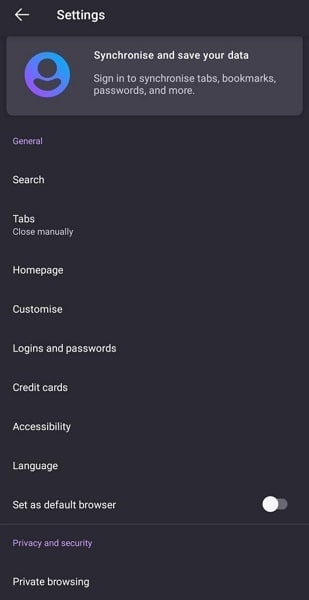
Step 2: Now, tap “Site Permissions” and select “Location.” In the “Location” option, select “Blocked” to disable the location access on the Firefox browser.

On iPhone
Step 1: On your iPhone, open “Settings” and scroll down to “Firefox.” After locating the app, select it and press “Location” on the next screen.

Step 2: In the “Location” menu, you can select “Never” to completely disable the location access for the Firefox browser. To only stop Firefox from detecting your accurate location, turn off the toggle of the “Precise Location” option.

Method 2: Spoof Your Location in Firefox Using Dr.Fone - Virtual Location
Nowadays, many websites work with the help of location-based services. Disabling geolocation from the Firefox browser means they won’t work. It means you need a tool that can change your Firefox location without affecting your favorite platforms.
Wondershare Dr.Fone - Virtual Location provides you with an excellent way to do Firefox location spoofing. You will not have to worry about websites or apps detecting your location as fake when using this tool.
Dr.Fone - Virtual Location
1-Click Location Changer for both iOS and Android
- Teleport from one location to another across the world from the comfort of your home.
- With just a few selections on your computer, you can make members of your circle believe you’re anywhere you want.
- Stimulate and imitate movement and set the speed and stops you take along the way.
- Compatible with both iOS and Android systems.
- Work with location-based apps, like Pokemon Go , Snapchat , Instagram , Facebook , etc.
3981454 people have downloaded it
Main Features of Dr.Fone - Virtual Location
- Dr.Fone - Virtual Location allows you to play location-based games. It includes games like Pokémon Go, Minecraft Earth, and Jurassic World Alive, all from the comfort of your bed.
- If you use a dating app like Tinder or Bumble, you can increase your likes and matches using this tool.
- You can bypass the geo-restriction of apps and enjoy their content with the tool’s help.
Steps Required for Spoofing Location in Firefox via Dr.Fone - Virtual Location
Using Dr.Fone- Virtual Location to spoof your location in Mozilla Firefox is simple and quick. You will need to install Dr.Fone on your computer and follow these steps for location spoofing:
Step 1: Install Dr.Fone on Your System
Download and install Dr.Fone on your computer and connect your phone to it. Access Dr.Fone, select “Virtual Location,” and click “Get Started” on the next screen to begin the process.

Step 2: Activate the Teleport Mode on Dr.Fone
After clicking “Get Started, “ a map will open where you must select your original location. It can be done using the “Center On” icon from the right sidebar. To choose your fake location, you will need to activate “Teleport Mode” from the top right corner.
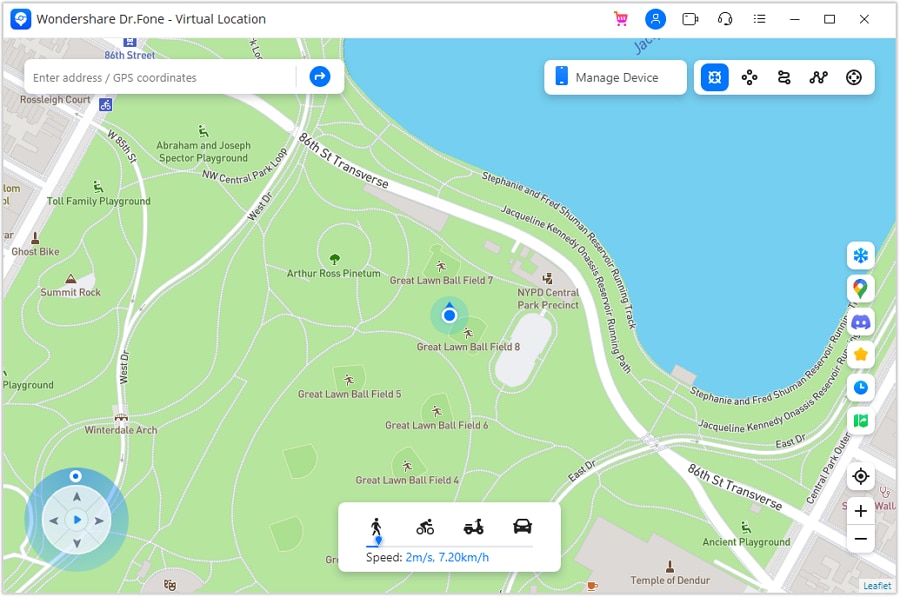
Step 3: Spoof Your Location in Firefox
Enter your desired fake location in the provided space and press “Go” once the mode is activated. It will take you to the entered location, where you need to select “Move Here” to complete the process. You can confirm the location spoof by opening any location-based app on your phone.
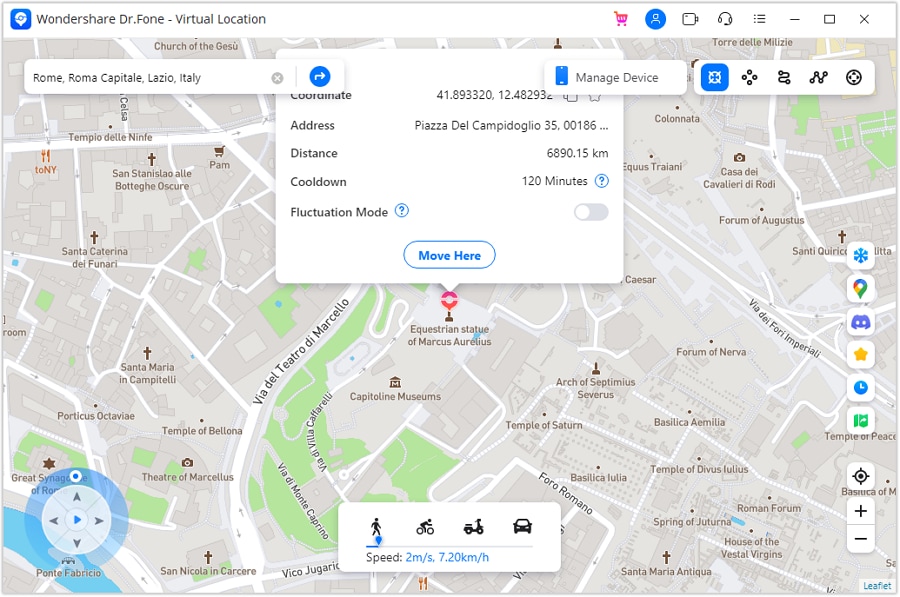
Method 3: Change Your Location in Firefox Using ExpressVPN
Browsers like Mozilla Firefox tracks your location by using your IP address. You can use a VPN to spoof your IP location to protect your actual location from websites. ExpressVPN is a VPN that is available for both Android and iOS devices. You can use these steps to change your location using ExpressVPN:
Step 1: Install ExpressVPN on your phone and create an account for it. If you are already a user of ExpressVPN, then log in with your account.
Step 2: Select your desired fake location from the “Smart Location” tab after logging in. Once a location is selected, press “Connect” to change to the desired fake location.

Conclusion
In today’s digital world, you have to compromise your privacy to some extent. However, it doesn’t mean that you should not try to use tools available to you to protect your privacy to the limit. Dr.Fone - Virtual Location solves your concerns regarding location sharing with ease. With this tool, you can fake location in Firefox and still enjoy all the features and services offered by location-based websites and apps.
Prevent Cross-Site Tracking on Motorola Edge 40 and Browser
Have you ever wondered why you get the advertisements of the websites you visited a few minutes ago on your social media sites? Here comes to Cross-Site Tracking, also termed CST, and it is a process where third-party cookies and sites track your browser history.
![]()
The CST process is like invading your privacy by collecting your browser history and personal information. So, to prevent these services, there are several ways by which you can cross-site tracking on your system as well as Motorola Edge 40 phone browsers. Keep reading to learn how to stop cross-site tracking on both Motorola Edge 40 and browser.
Part 1: Why Do We Need to Stop Cross-site Tracking?
Cross-site Tracking is all about collecting your browsing data and other information for advertising purposes. Though the process can prove convenient for many as it provides additional information about the products and services you have searched for and offers tailor-made content, it is intrusive and about breaching your privacy.
Cross-site tracking collects information about your browsing history. The third-party cookies also monitor the content type you have visited and your personal information, which is risky.
Besides invading privacy, the CST also poses several other issues. Based on your browsing history, additional content you have not asked for is loaded on your visited sites, slows down the page loading process, and puts an extra burden on your battery. Moreover, too much-unwanted content can interfere with the basic information you are looking for.
So, it is always better to prevent cross-site tracking for all the above and more reasons.
Further reading: A detailed guide on faking location in Mozilla Firefox . Don’t worry about your location privacy anymore!
Part 2: Can Private Browsing be traced?
Yes, private browsing can be traced. When you work in private browsing mode, the web browser does not save the browsing history, which means that anyone who uses your system will not check your online activities. But websites and cookies can track your browsing history as well as other information.
Part 3: How to Disable Cross-website Tracking on Safari for iOS Devices?
Safari is the most commonly used platform by iOS users. So, to prevent CST for Safari on your iOS devices and Mac systems, below is a complete guide.
Deactivate Safari cross-website tracking for iPhone & iPad
Safari cross-site tracking can be prevented using the below steps on your iPhone and iPad.
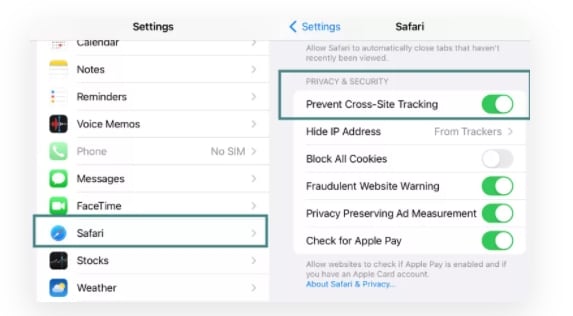
- Step 1. Launch the Settings app on your iOS device.
- Step 2. Find the Safari option by scrolling down the menu.
- Step 3. Move the slider to turn on “Prevent Cross-Site Tracking” under the PRIVACY & SECURITY option.
Deactivate Safari cross-website tracking for Mac
Use the steps below to turn off cross-site tracking on Safari on your Mac systems.
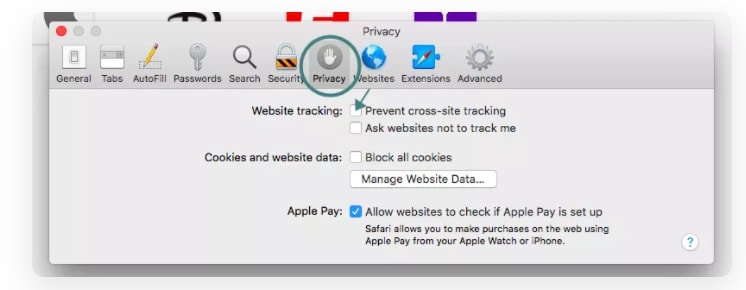
- Step 1. On your Mac system, open the Safari app.
- Step 2. Move to Safari > Preferences > Privacy
- Step 3. Enable the “Prevent cross tracking” option by clicking on the box next to it.
Part 4: How to Disable Cross-site Tracking on Google Chrome
Chrome is used widely on Windows systems and Android devices, and to prevent the CST from your browser, a detailed guide is given below.
Enable “Do Not Track” on Google Chrome for Android
- Step 1. On your Motorola Edge 40, open the Chrome app.
- Step 2. At the right side of the address bar, click on the More option and choose Settings.
- Step 3. Choose the Privacy option from the Advanced tab.
- Step 4. Click on the “Do Not Track” option to turn on the feature.
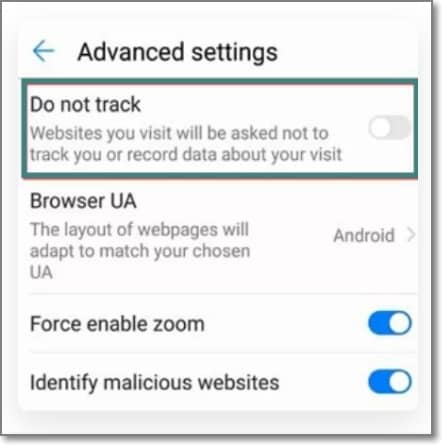
Enable “Do Not Track” on Google Chrome for Computer
- Step 1. Launch Chrome on your system, and from the menu at the upper-right corner, click on the Settings option.
- Step 2. From the “Privacy and Security” tab, choose the “Cookies and other site data” option.
- Step 3. Tap and enable the slider next to “Send a “Do not track” request with your browsing traffic.”
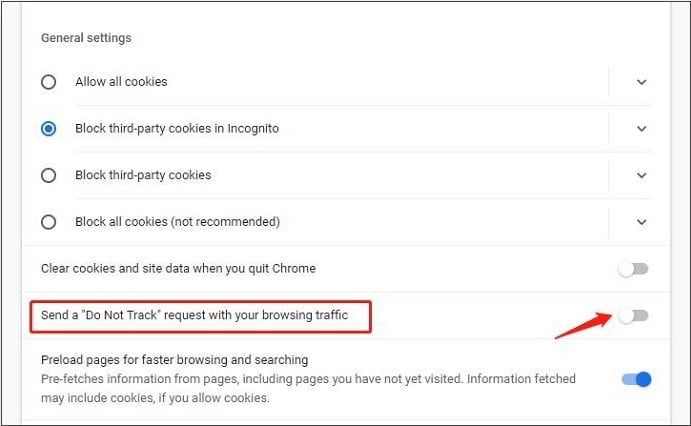
Part 5: Recommended Solution: Fake a Location to Stop Cross-Site Location Tracking Using Dr. Fone
What if you let the sites and cookies track your phone location without worrying about your privacy? Yes, it can be done by spoofing your location. So, if you set a fake location while browsing the internet, you will not have to worry about cross-site tracking, as anyways, the sites and cookies will get misled browsing information that cannot harm you in any manner.
Setting a fake location on your iOS devices, a professional tool is needed, for we recommend Wondershare Dr.Fone - Virtual Location as the best tool. Using this Android and iOS-based software, you can set any fake GPS location on your device. The tool is simple to use and does not require any mastery of technical know-how.
Key features
- Simple tool to teleport to any GPS location in a single click.
- Allows simulating GPS movement along the route.
- All popular models of Android and iOS devices are compatible.
- Compatible with all location-based apps on your phone.
- Compatible with Windows and Mac systems.
Here is a video tutorial for you to take an overview of how to use Dr.Fone - Virtual Location to fake location on your Android and iOS devices.

Steps to set fake location on your Android and iOS devices using DrFone-Virtual Location
Step 1. Download, install and launch the software on your Windows or Mac systems. On the main software interface, choose the Virtual Location option.

Step 2. Connect your iPhone or Android device to your system using a USB cable and then tap on the Get Started option on your software interface.

Step 3. A new window on the software interface will open, showing your connected phone’s real and actual location. If the detected location is incorrect, click on the “Center On” icon to display the right device location.

Step 4. Next, you need to activate the “teleport mode” and click o the 3rd icon at the upper-right corner.
Step 5. Next, you have to enter now the fake location to which you wish to teleport to at the upper-left corner. Click on Go.
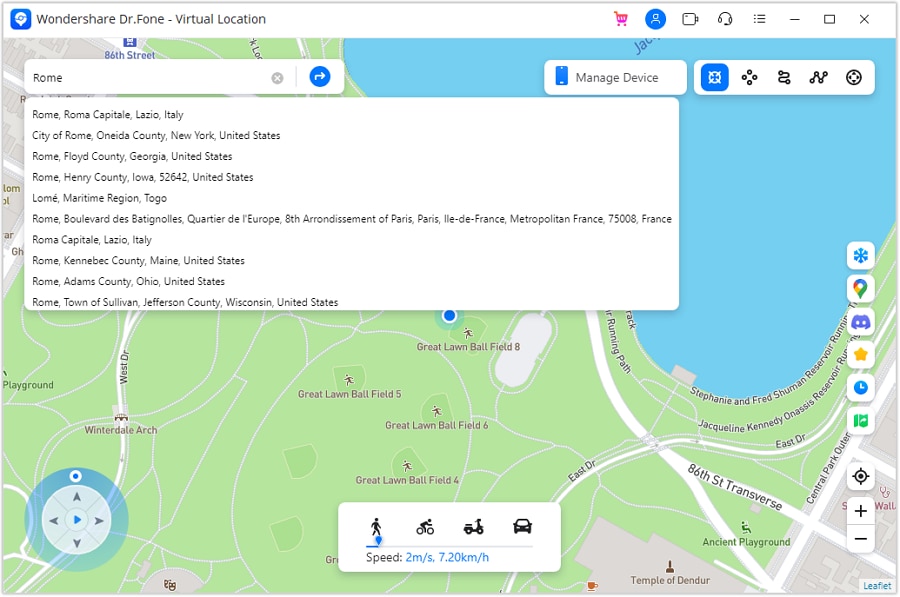
Step 6. Finally, tap on the Move Here button and the new fake location for your connected Android or iOS device at the pop-up box.

Check the new location of your phone from the app.
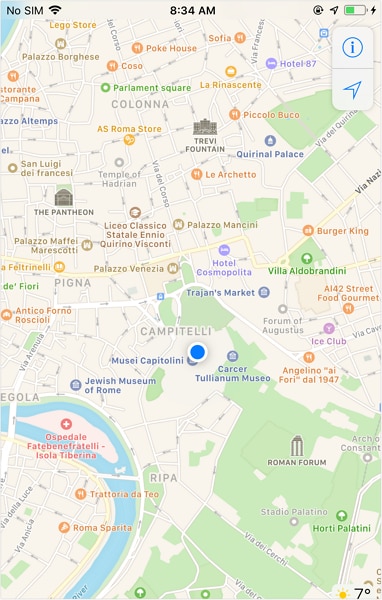
Wrap it up
Preventing Cross-site tracking can be done on different browsers and devices using the guides listed in the above parts of the article. Settings a fake location for your device using Dr. Fone-Virtual Location is another interesting way to prevent tracking your browsing history by spoofing the sites and cookies. Setting a fake place will not only avoid monitoring your browsing history but will also work with all location-based apps on your phone.

3 Ways to Fake GPS Without Root On Motorola Edge 40
Fake GPS is an Android application for tweaking your GPS settings. It will help you avoid being tracked by your parents or a stranger spying on you in many situations. Faking GPS will also aid you in using an application that is banned in your region or playing a trick in the games like Pokemon Go.
In other words, it is called GPS spoofing. Some users believe in a misconception that the Motorola Edge 40 device will have to be rooted for GPS spoofing. But that’s wrong. It’s possible to alter the location without rooting your phone. If you have no idea how to fake GPS no root and want to know more, keep reading this article. We created this guide to curb your worries and help you fix your issue! Let’s begin now!
Part 1: The one-stop way to fake GPS on your iOS and Android without root
Have trouble catching Pokemon? Or maybe you’re trying to get a date. Whatever your reason, with Dr. Fone’s Virtual Location, you can quickly teleport your phone to anywhere in the world with a single click. You can even move along a route that you draw!
Try it with location-based apps like Pokemon Go or Tinder to fake movement and enjoy all the fun on the go. It works perfectly with any application to fake GPS without root. The app is compatible with Windows and macOS devices to use any of them for GPS spoofing on your smartphone.
Dr.Fone - Virtual Location
1-Click Location Changer for both iOS and Android
- Teleport from one location to another across the world from the comfort of your home.
- Fake GPS location on Android without root.
- Stimulate and imitate movement and set the speed and stops you take along the way.
- Compatible with both iOS and Android systems.
- Work with location-based apps, like Pokemon Go , Snapchat , Instagram , Facebook , etc.
3981454 people have downloaded it
Steps to fake GPS no root on your iOS and Android
Step 1: Download Dr. Fone
Download Dr.Fone – Virtual Location on your PC and run it to begin fake GPS without root. Then, choose “Virtual Location” from the given options from the home interface.

Step 2: Connect Your Device
Connect your iOS device with the lightning cable or your Motorola Edge 40 using a USB cable. You can also connect your iOS device via WiFi after being connected once. Click on “Get Started” now.

Step 3: Set the Accurate Location
Before GPS spoof without root, you have to find and set your actual location on the map. If the location is not shown correctly, hit the “Center On” icon located at the lower right part.

Step 4: Turn on Teleport Mode
Click the second icon present in the upper right to turn on the “teleport mode.” Now, type where you want to teleport in the space given on the top left. After that, click “Go” to start a fake GPS with no root.

Step 4: Chance the Location
Now, you will be able to trick all the location-based apps with your fake location. Click on “Move Here” when the popup box shows.

Even when you click the “Center On” icon for location yourself, the location will remain fixed to where you have done teleporting.
Part 2: Other APPs to fake GPS without jailbreak no root
Fake GPS Location – Hola
Other than Dr.Fone, you can use its alternative Hola on Android devices. It’s available to use in more than 43 languages free of cost. With this fake GPS Android no root application, you can choose from an extensive list of places worldwide to set your location. For android users who can’t afford a PC or laptop to perform GPS spoofing with Dr.Fone, they can choose Hola for convenience.

Pros
- Quick to alter the location to wherever you want in the world.
- Pretty easy to use by anyone you wish without any hassle.
- You will not see any ads.
- The interface is user-friendly.
Cons
- Many times, the cursor doesn’t work correctly.
- It can drain your device’s battery, unlike Dr.Fone – Virtual Method.
Fake GPS Go Location Spoofer
Fake GPS Go Location Spoofer is a perfect solution for those looking for a reliable GPS spoofer. It is available as an app, eliminating the need to be rooted to use it. Additionally, it’s incredibly simple to use and can fool all Geo-location based applications on your device.
You’ll have fun letting your friends think you’re partying like a rock star or relaxing on some tropical island while they are stuck at the office or school doing work.
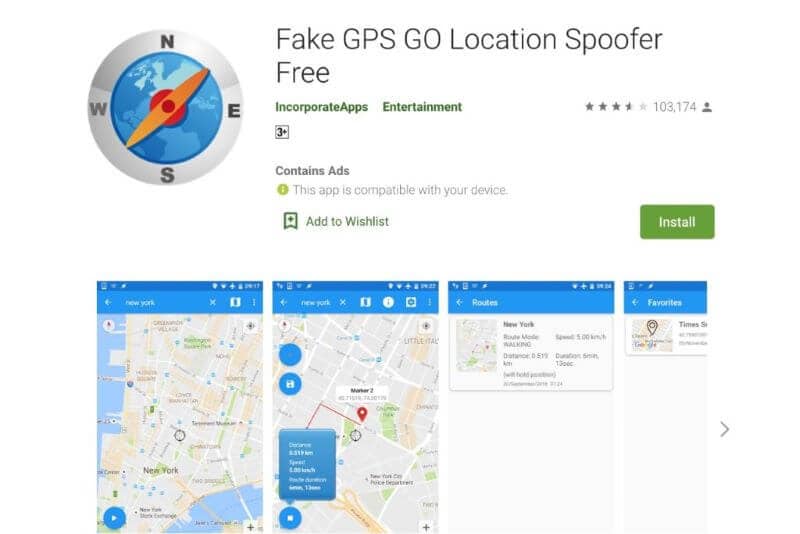
Pros
- It can be used with a joystick to match the movement on the screen.
- It can be integrated with other third-party applications using the share button.
- Helps in altering location change frequency.
- You can customize routes easily.
Cons
- It Consumes too much battery.
- It doesn’t work on all GPS-related apps.
GPS Emulator
GPS emulator is another such application that helps you in fake GPS no root. If you’re looking to fake your location without too many advanced features, this might be for you. It’s straightforward, and it gets the job done quickly. It demands modification in your Motorola Edge 40 setting like turning on the developer mode, deactivating mock location, etc.

Pros
- Provides access to three map types for allowing you to teleport location conveniently.
- Permit you to enable or disable GPS coordinates injection for Google services.
- Easy switching to a different map mode.
- Easy to use.
Cons
- No updates for so long.
- May heat up the phone if used for long.
Conclusion
If you plan to root your device to fake GPS without mock location no root, drop that idea. You are now aware of some of the best ways to fake GPS without rooting your device. It’s highly recommended to use Dr.Fone - Virtual Location when you want to do more and change your GPS location.
Also read:
- [New] In 2024, Character Voiceovers and Personas for Dynamic TikTok Content
- [New] In 2024, Essential 8 Linux Software for Editors
- Comprehensive Fix for When Your System Can't Find Helper.dll
- Here Are Some Reliable Ways to Get Pokemon Go Friend Codes For Xiaomi Redmi Note 12 Pro+ 5G | Dr.fone
- In 2024, 3 Ways for Android Pokemon Go Spoofing On Vivo Y27 5G | Dr.fone
- In 2024, 4 solution to get rid of pokemon fail to detect location On Vivo Y56 5G | Dr.fone
- In 2024, Leveraging Azure's Speech-to-Text for Enterprise Solutions
- Latest way to get Shiny Meltan Box in Pokémon Go Mystery Box On Vivo Y77t | Dr.fone
- New In 2024, Creative Cinema for Kids Bring Your Imagination to Life
- Quick Shot Guide for Chromebook Users for 2024
- Sing Your Heart Out with These Premiere Karaoke Machines of 2024!
- Ultimate guide to get the meltan box pokemon go For Vivo X Fold 2 | Dr.fone
- What are Location Permissions Life360 On Realme V30T? | Dr.fone
- Title: In 2024, A Detailed Guide on Faking Your Location in Mozilla Firefox On Motorola Edge 40 | Dr.fone
- Author: Nova
- Created at : 2025-02-25 08:41:21
- Updated at : 2025-03-03 07:29:53
- Link: https://change-location.techidaily.com/in-2024-a-detailed-guide-on-faking-your-location-in-mozilla-firefox-on-motorola-edge-40-drfone-by-drfone-virtual-android/
- License: This work is licensed under CC BY-NC-SA 4.0.